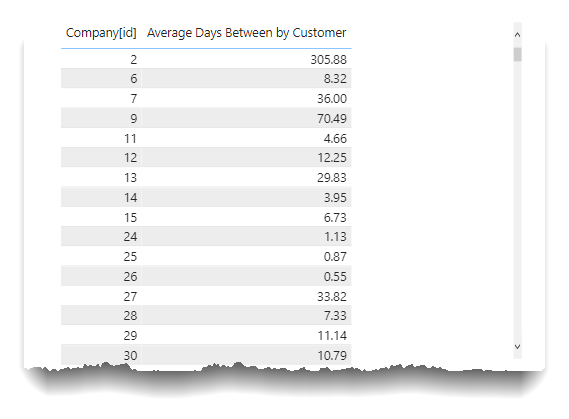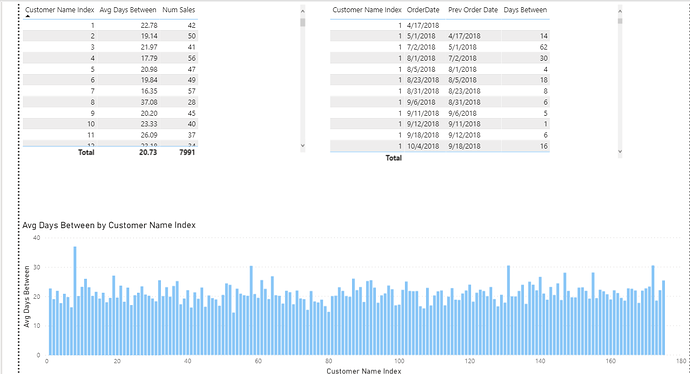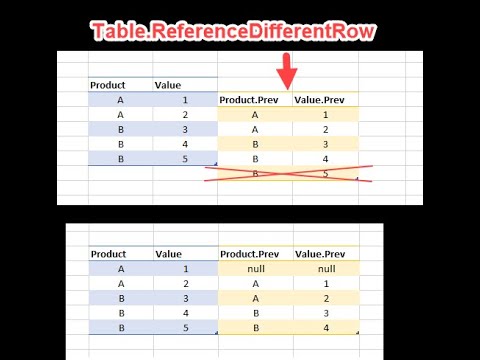Hi @MAAbdullah47, we’ve noticed that no response has been received from you since the 10th of November. We just want to check if you still need further help with this post? In case there won’t be any activity on it in the next few days, we’ll be tagging this post as Solved. If you have a follow question or concern related to this topic, please remove the Solution tag first by clicking the three dots beside Reply and then untick the checkbox. Thanks!
I responded, I put Like on the solution, if there is a need for another action please advice.
Hi @MudassirAli
Please check this example:
Hi @AlB
Customer X
I need to calculate the difference between each order (n) and Order (n+1) how many days?
then from Order (n+1) to Order (n+2) How many days?
…etc
Customer X+1
I need to calculate the difference between each order (n) and Order (n+1) how many days?
then from Order (n+1) to Order (n+2) How many days?
…etc
Then I need the (Average Days) Between Orders for all customers is the question clear?
I have reworked the solution, eliminating the use of EARLIER by replacing it with a variable tracking the current row context. I have also converted all of the prior calculated columns to measures, and I believe the solution is now working properly per your requirements.
I’ve attached the revised solution file - please take a look and let me know if this meets your needs. Thanks.
- Brian
Thank you So much @BrianJ, I belive this solution is much accurate than the Pure Indexing , Many thanks.
Great – glad to hear that solution met your needs. I appreciated your input, and I do agree that for your use case, working directly with the dates ended up being a much better approach than using an intermediate index field. I also appreciated @MudassirAli’s comment that using variables was preferable to the use of EARLIER, and think that also improved the revised solution. Nice teamwork all around on this one.
- Brian
Hi @BrianJ
Follow-up , the results are accurate and works 100% , but it has one limitation (The performance) will be very slow if you have big data > 2M it will gives out of memory problem, we will try to digg down how to solve the performance issue.
Sorry – didn’t see your question. FYI – in the future, you’ll get a faster response if instead of responding to a closed thread, you start a new topic.
While I’m not saying there aren’t ways potentially to optimize the solution I provided, I don’t think the improvement will be significant enough to give you a satisfactory result given the size of your dataset. There are certain DAX operations, such as RANKX, that are very calculation intensive and even when optimized are relatively slow. The previous value pattern at the core of this solution is another of those calculation intensive operations. Thus, I think the best bet for your situation would be to rework the solution in Power Query. It still may take significant time to execute it there, but at least you can do it on scheduled refresh and then once the report is open, it should perform quite well.
Imke Feldmann has provided a simple, and highly optimized approach to obtaining previous value in power query, using two indexes – one starting at 1, and the other at 0. Here’s a blog entry that explains the process in detail:
I hope this is helpful, and invite others with more expertise in optimization to chime in here with their thoughts.
- Brian
Hi Brian, I tried to implement this solution to my dashboard but when I try to load a table with my Customer Name, Order Date and then drop in Prev Order Date, I just get the circle spinning in the top left corner infinitely. There’s no issue with relationships and the file file size is relatively small.
@Ndz1985 ,
Sorry, but there’s not enough information for me to diagnose what the problem is. I’ve run this solution on some pretty large datasets without a problem. If you can post your PBIX file, I’d be glad to take a look.
- Brian
Hi Brian,
Thanks for the reply.
.pbx available below:
https://drive.google.com/file/d/1t8vYBQdFt5Iky-Dp0ux-AV-cDt8l9C2p/view?usp=sharing
@Ndz1985 ,
I tested the DAX solution on your dataset, and it produces the right results but runs unacceptably slowly.
If you can please also send me the underlying data file in Excel or CSV, I will work on the Power Query solution, and see if I can get it to run at an acceptably fast speed using the Feldmann shift technique.
Thanks!
– Brian
Hi @BrianJ
Thank you for your email , The data is the same for (EDNA) it is public DB you can take it from this forum , But i get your solution and practice it on my data , that is right it make the performance slow but the solution work 100%.
Thanks for your message. I was actually requesting @Ndz1985 's data file, since we are working on the same problem that you and I worked on, but his dataset is over a million rows, so the DAX solution is just not very workable. Going to rework this in Power Query to try to speed it up.
– Brian
Hi Brain,
Really appreciate your assistance here. I’ve exported the max I can to .csv. SQL Server didn’t export the headers so I’ve entered what I think the important ones are. If you need others please let me know.
https://drive.google.com/file/d/1y0VhrwSS7vWUJeZnR5x-0rrj0uz7_KzG/view?usp=sharing
@Ndz1985 ,
OK, I think I’ve got a pretty good outcome for you on this now.
The DAX-only visual took minutes to run, whereas if you do most of the heavy lifting in PQ, I’ve got the results down to being able to run the following results in under 3.5 seconds:

In truth, the PQ portion still takes a long time to run, but that perhaps can be done on scheduled refresh so that the user doesn’t bear the refresh time delay.
Basically, what I did was added a 0-based index and a 1-based index to the sales table, and did a self-join on the two index columns (i.e., the “Feldmann Shift”, named for Imke Feldmann who first published this technique). This is an efficient way to calculate any previous value in PQ. I then wrote a couple of simple custom M statements to check that previous dates weren’t crossing over customers and then subtracted the current and previous date for each line.
let
Source = Csv.Document(File.Contents("C:\Users\brjul\Desktop\export\Data-Sales.csv"),[Delimiter=",", Columns=17, Encoding=1252, QuoteStyle=QuoteStyle.None]),
#"Promoted Headers" = Table.PromoteHeaders(Source, [PromoteAllScalars=true]),
#"Changed Type" = Table.TransformColumnTypes(#"Promoted Headers",{{"Sales[id]", Int64.Type}, {"Sales[CompanyID]", Int64.Type}, {"Sales[Reconciled Sales]", Int64.Type}, {"Sales[Quoted Sales Price]", Int64.Type}, {"Sales[DespatchDateLocal]", type text}, {"Sales[ToLocationId]", Int64.Type}, {"Sales[FromCompanyLocationId]", Int64.Type}, {"Sales[ConsignmentTrackingStatusId]", Int64.Type}, {"Sales[ToLocationId2]", Int64.Type}, {"Sales[CarrierServiceID]", Int64.Type}, {"Sales[TotalCostPrice]", Int64.Type}, {"Sales[TotalBaseCostPrice]", Int64.Type}, {"Sales[CarrierServiceID2]", Int64.Type}, {"Sales[TotalTaxCostPrice]", Int64.Type}, {"Sales[TotalVolume]", Int64.Type}, {"Sales[Sales Ex. GST]", Int64.Type}, {"Sales[Consignment Number]", type text}}),
#"Split Column by Delimiter" = Table.SplitColumn(#"Changed Type", "Sales[DespatchDateLocal]", Splitter.SplitTextByEachDelimiter({" "}, QuoteStyle.Csv, false), {"Sales[DespatchDateLocal].1", "Sales[DespatchDateLocal].2"}),
#"Changed Type1" = Table.TransformColumnTypes(#"Split Column by Delimiter",{{"Sales[DespatchDateLocal].1", type date}}),
#"Removed Columns" = Table.RemoveColumns(#"Changed Type1",{"Sales[DespatchDateLocal].2"}),
#"Sorted Rows" = Table.Sort(#"Removed Columns",{{"Sales[CompanyID]", Order.Ascending}, {"Sales[DespatchDateLocal].1", Order.Ascending}}),
#"Added 0-based Index" = Table.AddIndexColumn(#"Sorted Rows", "Index", 0, 1, Int64.Type),
#"Added 1-based Index" = Table.AddIndexColumn(#"Added 0-based Index", "Index.1", 1, 1, Int64.Type),
#"Merged Queries" = Table.NestedJoin(#"Added 1-based Index", {"Index"}, #"Added 1-based Index", {"Index.1"}, "Added Index1", JoinKind.LeftOuter),
#"Expanded Added Index1" = Table.ExpandTableColumn(#"Merged Queries", "Added Index1", {"Sales[CompanyID]", "Sales[DespatchDateLocal].1"}, {"Sales[CompanyID].1", "Sales[DespatchDateLocal].1.1"}),
#"Reordered Columns" = Table.ReorderColumns(#"Expanded Added Index1",{"Sales[id]", "Sales[CompanyID]", "Sales[CompanyID].1", "Sales[Reconciled Sales]", "Sales[Quoted Sales Price]", "Sales[DespatchDateLocal].1", "Sales[ToLocationId]", "Sales[FromCompanyLocationId]", "Sales[ConsignmentTrackingStatusId]", "Sales[ToLocationId2]", "Sales[CarrierServiceID]", "Sales[TotalCostPrice]", "Sales[TotalBaseCostPrice]", "Sales[CarrierServiceID2]", "Sales[TotalTaxCostPrice]", "Sales[TotalVolume]", "Sales[Sales Ex. GST]", "Sales[Consignment Number]", "Index", "Index.1", "Sales[DespatchDateLocal].1.1"}),
#"Renamed Columns" = Table.RenameColumns(#"Reordered Columns",{{"Sales[CompanyID].1", "Previous Sales Company ID"}, {"Sales[id]", "ID"}, {"Sales[Reconciled Sales]", "Reconciled Sales"}, {"Sales[Quoted Sales Price]", "Quoted Sales Price"}, {"Sales[DespatchDateLocal].1", "DespatchDateLocal.1"}, {"Sales[ToLocationId]", "ToLocationId"}, {"Sales[FromCompanyLocationId]", "FromCompanyLocationId"}, {"Sales[ConsignmentTrackingStatusId]", "ConsignmentTrackingStatusId"}, {"Sales[ToLocationId2]", "ToLocationId2"}, {"Sales[CarrierServiceID]", "CarrierServiceID"}, {"Sales[TotalCostPrice]", "TotalCostPrice"}, {"Sales[TotalBaseCostPrice]", "TotalBaseCostPrice"}, {"Sales[CarrierServiceID2]", "CarrierServiceID2"}, {"Sales[TotalTaxCostPrice]", "TotalTaxCostPrice"}, {"Sales[TotalVolume]", "TotalVolume"}, {"Sales[Sales Ex. GST]", "Sales Ex. GST"}, {"Sales[Consignment Number]", "Consignment Number"}, {"Index", "Index 0-based"}, {"Index.1", "Index 1-based"}, {"Sales[DespatchDateLocal].1.1", "DespatchDateLocal Previous"}}),
#"Reordered Columns1" = Table.ReorderColumns(#"Renamed Columns",{"ID", "Sales[CompanyID]", "Previous Sales Company ID", "DespatchDateLocal.1", "DespatchDateLocal Previous", "Reconciled Sales", "Quoted Sales Price", "ToLocationId", "FromCompanyLocationId", "ConsignmentTrackingStatusId", "ToLocationId2", "CarrierServiceID", "TotalCostPrice", "TotalBaseCostPrice", "CarrierServiceID2", "TotalTaxCostPrice", "TotalVolume", "Sales Ex. GST", "Consignment Number", "Index 0-based", "Index 1-based"}),
#"Renamed Columns1" = Table.RenameColumns(#"Reordered Columns1",{{"DespatchDateLocal.1", "DespatchDateLocal"}}),
#"Added Custom" = Table.AddColumn(#"Renamed Columns1", "Previous Order Date", each if [#"Sales[CompanyID]"] = [Previous Sales Company ID] then [DespatchDateLocal Previous] else null),
#"Reordered Columns2" = Table.ReorderColumns(#"Added Custom",{"ID", "Sales[CompanyID]", "Previous Sales Company ID", "DespatchDateLocal", "DespatchDateLocal Previous", "Previous Order Date", "Reconciled Sales", "Quoted Sales Price", "ToLocationId", "FromCompanyLocationId", "ConsignmentTrackingStatusId", "ToLocationId2", "CarrierServiceID", "TotalCostPrice", "TotalBaseCostPrice", "CarrierServiceID2", "TotalTaxCostPrice", "TotalVolume", "Sales Ex. GST", "Consignment Number", "Index 0-based", "Index 1-based"}),
#"Added Custom1" = Table.AddColumn(#"Reordered Columns2", "Days Between", each if [Previous Order Date] = null then null else [DespatchDateLocal] - [Previous Order Date]),
#"Changed Type2" = Table.TransformColumnTypes(#"Added Custom1",{{"Days Between", Int64.Type}})
in
#"Changed Type2"
All that’s left to do is calculate the average days between by customer, which I did via the following DAX measure (although it could be done in PQ if you don’t need for this to be dynamic, say sliced by date).
Average Days Between by Customer =
CALCULATE(
AVERAGE( Sales[Days Between] ),
ALLEXCEPT(
Company,
Company[id]
)
)
I hope this is helpful. Full solution file attached. (Note: I had trouble with your CSV file, so I pushed the whole set of CSV files out of the model with Power BI Exporter, and then reimported them - that’s why some of the column names are wonky…)
- Brian



